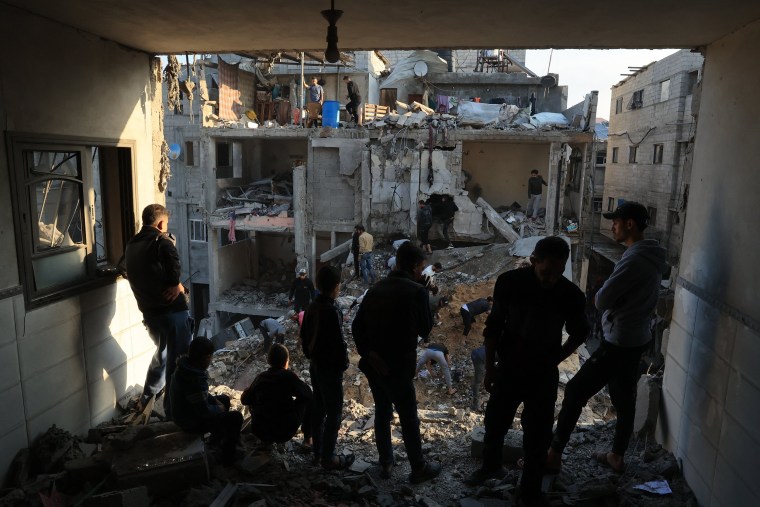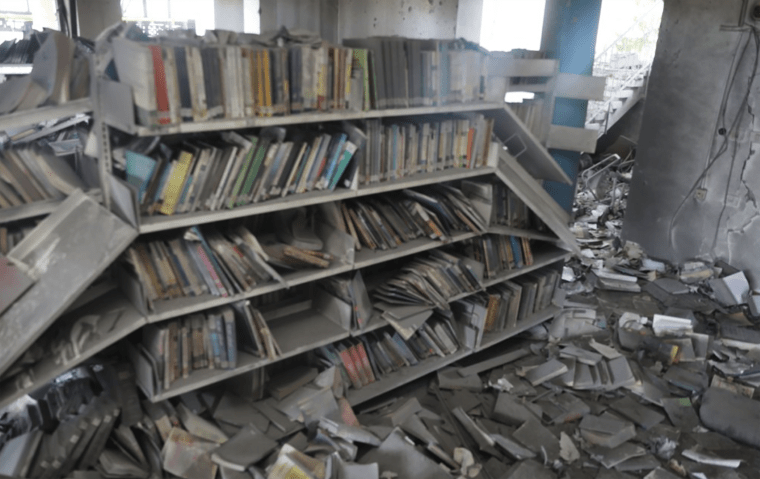The Palestinian newlyweds stood in front of the rubble that was once the home where they planned to build a life.
Yasmine Abu Rujileh, 23, and Khalil Al Najjar, 26, married just a month before war broke out Oct. 7. Their honeymoon was spent fleeing across southern Gaza as Israeli airstrikes pummeled the neighborhoods around them.
“We were living a happy life, but this happiness is gone and everything with it,” Abu Rujileh told an NBC News crew at the scene as the couple searched through the debris hoping to find winter clothes.
Across the Gaza Strip, displaced Palestinian families used the brief calm before the resumption of bombing Friday to venture out to see if their homes were still standing.
Many, like Abu Rujileh and Al Najjar, are finding only wreckage.
A new data analysis finds that in Gaza City and the north of the strip, around half of all buildings have either been damaged or completely destroyed during Israel’s seven-week offensive in response to the Oct 7. Hamas terror attack.

In the south of Gaza, where Israel has urged Palestinian civilians to flee for their own safety, the damage is less extensive but still stark. In Khan Younis, between 10% to 15% of all buildings have been damaged, according to the research.
The data, compiled by researchers at Oregon State University and the City University of New York Graduate Center, is based on an analysis of imagery from the Copernicus Sentinel-1, a satellite operated by the European Space Agency.
Gaza has been left reeling by the death toll of the last seven weeks. More than 15,000 people were killed according to the Hamas-run Health Ministry, most of them in Israeli airstrikes. Proportional to the population, that is the equivalent of around 2.4 million Americans, or roughly the population of Houston.
But the scale of the physical devastation has also given many Gazans the bewildering sense that the strip where they lived their entire lives is disappearing before their eyes, replaced by unrecognizable swaths of destruction.
A visual analysis by NBC News finds many of Gaza’s best-known landmarks are now in ruins. The Square of the Unknown Soldier was once a popular park in the heart of Gaza City, its perimeter lined with trees and a playground for children on one side.
Today, the square is a stretch of brown dirt. The trees are uprooted. And the playground is lost somewhere in the tangle of metal. The Gaza City municipality says Israeli forces used bulldozers to flatten it as part of a campaign to “deliberately target” landmarks.
The Israel Defense Forces did not respond to a request for comment on this story.
A city library has also been destroyed. Images shared by the Gaza City municipality show children’s books on the floor, covered in ash. The Rashad Shawa Cultural Center, which hosted a theater and a library of its own, has also been reduced to rubble.
NBC News witnessed the destruction firsthand on a coastal stretch of northern Gaza while embedded with Israeli forces as they hunted for tunnels used by Hamas fighters. Few buildings were still standing, having been destroyed either by Israeli strikes or flattened by military construction vehicles.

One two-story home appeared undamaged on first approach. But once inside, it became clear that several of its exterior walls had been blown up, exposing its staircase to the elements.
More than half of Gaza’s 2 million residents have been displaced by the fighting and many now have no homes to return to — a housing crisis that will long outlast the current conflict but is becoming more acute by the day as winter sets in.
In Khan Younis, Abu Rujileh and Al Najjar sifted through the debris of what was once their bedroom as they looked for warm clothes. Little had survived the explosion but Abu Rujileh paused over a red plastic candy box. Inside were sweets given to them on their wedding night.
“We dug out our happiness from the ground,” she said, smiling sadly.